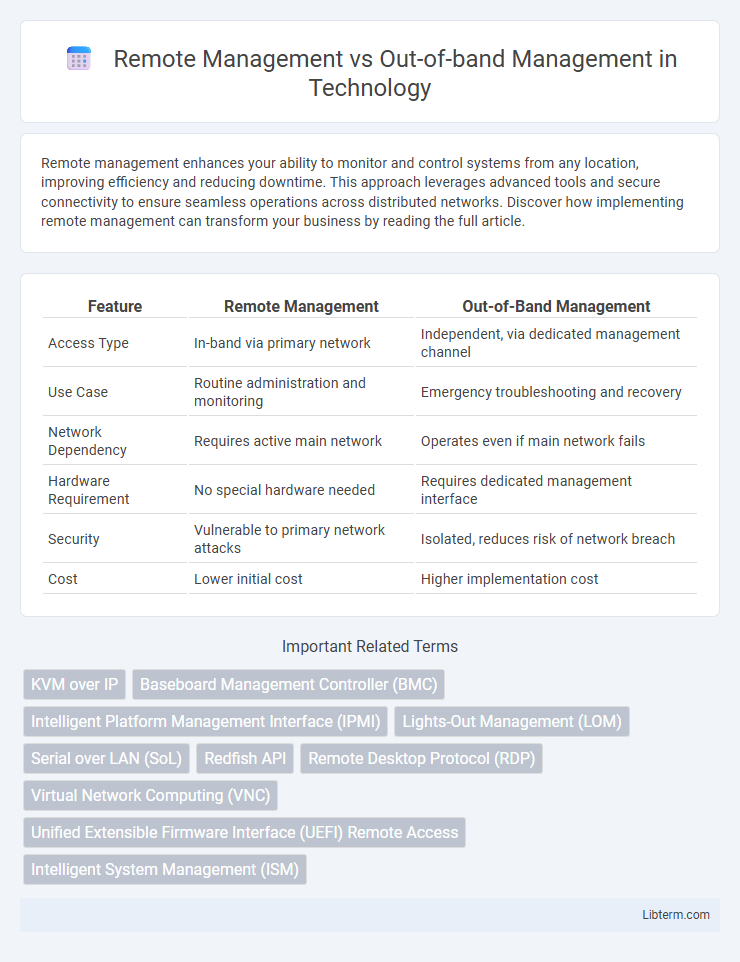Remote management enhances your ability to monitor and control systems from any location, improving efficiency and reducing downtime. This approach leverages advanced tools and secure connectivity to ensure seamless operations across distributed networks. Discover how implementing remote management can transform your business by reading the full article.
Table of Comparison
| Feature | Remote Management | Out-of-Band Management |
|---|---|---|
| Access Type | In-band via primary network | Independent, via dedicated management channel |
| Use Case | Routine administration and monitoring | Emergency troubleshooting and recovery |
| Network Dependency | Requires active main network | Operates even if main network fails |
| Hardware Requirement | No special hardware needed | Requires dedicated management interface |
| Security | Vulnerable to primary network attacks | Isolated, reduces risk of network breach |
| Cost | Lower initial cost | Higher implementation cost |
Introduction to Remote and Out-of-band Management
Remote management enables administrators to control and monitor network devices and systems from any location using standard network protocols, primarily relying on in-band communication. Out-of-band management provides a dedicated channel independent of the primary network, allowing access even during network failures or device malfunctions through interfaces like serial console ports or IP-based management cards. Both methods enhance IT operational efficiency and system uptime but differ in accessibility, reliability, and security features.
Defining Remote Management
Remote management enables IT administrators to monitor and control devices and systems from a central location using network-based tools, facilitating routine maintenance, software updates, and troubleshooting without physical presence. It relies on the primary network connection established through operating systems or management agents, allowing real-time access to hardware and software resources. This approach contrasts with out-of-band management, which uses a separate management channel to maintain access during system failures or network outages.
Understanding Out-of-band Management
Out-of-band management provides a dedicated, independent channel for accessing and controlling network devices, ensuring uninterrupted remote troubleshooting even when the primary network is down. This method uses separate hardware interfaces, such as serial ports or dedicated management cards, allowing administrators to monitor and manage critical systems without relying on the main data network. Compared to standard remote management, out-of-band management enhances network reliability, security, and rapid incident response by isolating management traffic from regular user data.
Core Differences Between Remote and Out-of-band Approaches
Remote management relies on the primary network connection to access and control devices, making it vulnerable to network failures or outages. Out-of-band management uses a separate, dedicated communication channel independent of the main network to ensure continuous access for troubleshooting and configuration even when the primary network is down. The core difference lies in the resilience and reliability of access methods, with out-of-band management providing a failsafe path for managing critical infrastructure during network disruptions.
Key Use Cases for Remote Management
Remote management enables IT administrators to oversee and control devices across networks, ideal for routine maintenance, software updates, and troubleshooting without physical presence. It is essential for managing dispersed endpoints in enterprises, supporting tasks like system monitoring, configuration changes, and remote assistance. This method enhances operational efficiency and reduces downtime by facilitating timely interventions across diverse hardware and locations.
Critical Applications of Out-of-band Management
Out-of-band management provides a dedicated, secure channel for accessing IT infrastructure independently of the operating system or primary network, ensuring reliable control during system failures or outages. Critical applications include troubleshooting servers remotely, performing BIOS-level maintenance, and recovering systems when in-band connectivity is compromised. This capability is essential for maintaining uptime in data centers, managing critical network devices, and supporting disaster recovery protocols.
Security Considerations for Both Management Methods
Remote management relies on network accessibility and often uses standard protocols like SSH or RDP, which may expose systems to cyber threats if not properly secured with strong authentication and encryption. Out-of-band management operates independently of the primary network by using dedicated channels such as serial connections or cellular networks, offering enhanced security by ensuring access even during network outages and reducing exposure to common network attacks. Implementing robust access controls, regular firmware updates, and network segmentation is critical to safeguard both remote and out-of-band management systems effectively.
Performance and Reliability Comparisons
Remote management relies on in-band network connectivity, making it vulnerable to network congestion and failures, which can degrade performance and reduce reliability during critical operations. Out-of-band management utilizes a dedicated management channel independent of the primary network, ensuring consistent access and higher reliability even when the main network is down or experiencing performance issues. This separation enhances system uptime and enables faster issue resolution, making out-of-band management superior in scenarios demanding high reliability and consistent performance.
Choosing the Right Management Solution for Your Organization
Remote management enables IT teams to control and monitor devices over a network using standard protocols like SSH or RDP, ideal for routine tasks and software updates. Out-of-band management provides access to hardware-level controls independent of the operating system, using dedicated management interfaces such as IPMI or iLO, essential for troubleshooting during system failures or network outages. Organizations should evaluate their infrastructure complexity, uptime requirements, and security policies to select between remote and out-of-band management solutions that best support operational continuity and incident response.
Future Trends in IT Infrastructure Management
Remote management and out-of-band management are evolving with AI-driven automation and zero-trust security frameworks shaping future IT infrastructure management. The integration of edge computing and 5G connectivity enhances real-time monitoring and rapid incident response in distributed environments. Predictive analytics combined with remote and out-of-band solutions streamline resource allocation, minimize downtime, and enable proactive maintenance across hybrid cloud architectures.
Remote Management Infographic

 libterm.com
libterm.com